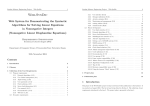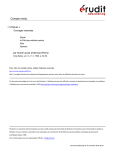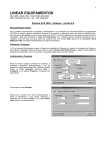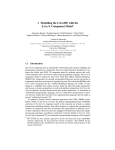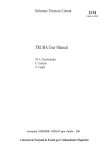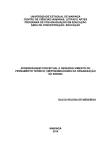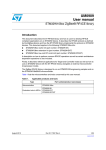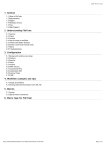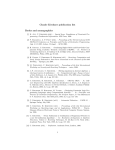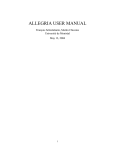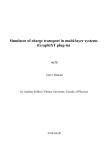Download User manual - Web
Transcript
Student Software Engineering Project: Web-SynDic
Petrozavodsk State University
Department of Computer Science
The Web-SynDic System
User Manual
2
Contents
1 Introduction
1.1 Overview . . . . . . . . . . . . . . . . . . . . . . . . . . . . . . . . . . . . . . . .
1.2 Conventions . . . . . . . . . . . . . . . . . . . . . . . . . . . . . . . . . . . . . .
3
3
3
2 Getting Started
2.1 Solving a test ANLDE system . . . . . . . . . . . . . . . . . . . . . . . . . . . .
2.2 Generating a test ANLDE system . . . . . . . . . . . . . . . . . . . . . . . . . .
2.3 Generating and solving a set of ANLDE systems . . . . . . . . . . . . . . . . . .
4
4
5
5
3 Reference manual
3.1 ANLDE system . . . . . . . . . . . . . . . . . . .
3.1.1 ANLDE system theory . . . . . . . . . . .
3.1.2 ANLDE system format . . . . . . . . . . .
3.2 Algorithms Configuration . . . . . . . . . . . . .
3.2.1 Solver limits . . . . . . . . . . . . . . . . .
3.2.2 Generator Limits . . . . . . . . . . . . . .
3.2.3 Generator Parameters . . . . . . . . . . .
3.3 Processing a test ANLDE system . . . . . . . . .
3.3.1 Creating ANLDE system . . . . . . . . . .
3.3.2 Solving ANLDE system . . . . . . . . . .
3.3.3 Saving ANLDE system . . . . . . . . . . .
3.4 Processing a set of ANLDE systems . . . . . . . .
3.4.1 Loading and solving ANLDE system set .
3.4.2 Generating and solving ANLDE system set
3.4.3 Generating and saving ANLDE system set
3.5 Server Load . . . . . . . . . . . . . . . . . . . . .
3.5.1 User Session . . . . . . . . . . . . . . . . .
3.5.2 Server load information . . . . . . . . . . .
3.6 Registration and Log In . . . . . . . . . . . . . .
3.7 User Profile Configuration . . . . . . . . . . . . .
3.8 Web-SynDic notes . . . . . . . . . . . . . . . . . .
.
.
.
.
.
.
.
.
.
.
.
.
.
.
.
.
.
.
.
.
.
.
.
.
.
.
.
.
.
.
.
.
.
.
.
.
.
.
.
.
.
.
.
.
.
.
.
.
.
.
.
.
.
.
.
.
.
.
.
.
.
.
.
.
.
.
.
.
.
.
.
.
.
.
.
.
.
.
.
.
.
.
.
.
.
.
.
.
.
.
.
.
.
.
.
.
.
.
.
.
.
.
.
.
.
.
.
.
.
.
.
.
.
.
.
.
.
.
.
.
.
.
.
.
.
.
.
.
.
.
.
.
.
.
.
.
.
.
.
.
.
.
.
.
.
.
.
.
.
.
.
.
.
.
.
.
.
.
.
.
.
.
.
.
.
.
.
.
.
.
.
.
.
.
.
.
.
.
.
.
.
.
.
.
.
.
.
.
.
.
.
.
.
.
.
.
.
.
.
.
.
.
.
.
.
.
.
.
.
.
.
.
.
.
.
.
.
.
.
.
.
.
.
.
.
.
.
.
.
.
.
.
.
.
.
.
.
.
.
.
.
.
.
.
.
.
.
.
.
.
.
.
.
.
.
.
.
.
.
.
.
.
.
.
.
.
.
.
.
.
.
.
.
.
.
.
.
.
.
.
.
.
.
.
.
.
.
.
.
.
.
.
.
.
.
.
.
.
.
.
.
.
.
.
.
.
.
.
.
.
.
.
.
.
.
.
.
.
.
.
.
.
.
.
.
.
.
.
.
.
.
.
.
.
.
.
.
.
.
.
.
.
.
.
.
.
.
.
.
.
.
.
.
.
.
.
.
5
5
5
10
11
11
12
12
13
13
17
21
22
22
25
26
27
27
28
28
30
31
4 Sysadmin Manual
4.1 Logging in as an administrator .
4.2 User management . . . . . . . .
4.3 Changing constraints . . . . . .
4.4 Viewing activity statistics . . .
.
.
.
.
.
.
.
.
.
.
.
.
.
.
.
.
.
.
.
.
.
.
.
.
.
.
.
.
.
.
.
.
.
.
.
.
.
.
.
.
.
.
.
.
.
.
.
.
.
.
.
.
.
.
.
.
.
.
.
.
.
.
.
.
.
.
.
.
33
33
33
35
35
.
.
.
.
.
.
.
.
.
.
.
.
.
.
.
.
.
.
.
.
.
.
.
.
.
.
.
.
.
.
.
.
.
.
.
.
.
.
.
.
Student Software Engineering Project: Web-SynDic
3
5 Installation and Configuration Instructions
38
San-serif font Names of forms and text areas available in Web-SynDic pages.
6 Frequently Asked Questions
39
Underlined text Names of links available in Web-SynDic pages.
7 Glossary
41
References
42
1
1.1
Introduction
Overview
Web-SynDic stands for web-based demonstration and test of the syntactic algorithms for
solving linear Diophantine equations in nonnegative integers. These algorithms, developed at
CS Department of PetrSU, are a novel type of algorithms for efficient solving some classes of
nonnegative linear Diophantine equations (NLDE or LDE in nonnegative integers) by syntactic
(parsing) methods.
These syntactic algorithms seem to be promising tool for solving some classes of NLDE system; more exactly a class of NLDE system, associated with formal grammars (ANLDE systems).
For this class the syntactic algorithms allow efficient (polynomial and pseudo-polynomial) computations comparing with the general NLDE case when the same computational problems are
NP-complete or even overNP [9].
A user just sends a test ANLDE system to Web-SynDic; the latter responds with the solution
and some characteristics of the computation. This allows to present the key features of the
syntactic algorithms, test them, estimate the efficiency, etc.
A user is assumed to be a researcher in Diophantine analysis, formal grammars, integer
programming, and related fields. She/He has an access to the Internet via a standard browser.
Note, that the web system does not allow a user to have a direct access to the demonstrated&tested algorithms but shows only the outcome of their work. Detailed information
about the syntactic algorithms and ANLDE theory can be found in [1, 2, 6, 7].
1.2
Student Software Engineering Project: Web-SynDic
2
Getting Started
Web-SynDic is a web system for demonstrating and testing novel syntactic method for searching
nonnegative integer solutions of Linear Diophantine Equations (LDE in nonnegative integers
or Nonnegative LDE or NLDE for short).
Web-SynDic works with a special class of homogeneous NLDE systems that are Associated
with context-free grammars (ANLDE systems for short).
2.1
Solving a test ANLDE system
For solving one ANLDE system use ANLDE system link in the left-side part of the main form.
This link opens Process an ANLDE System form. Input ANLDE system into the corresponding
text area (see Figure 1) or press button Generate to generate ANLDE system automatically
(see section 2.2), and press button Solve. The Solution Report page containing solved system,
Conventions
In this document the following conventions for fonts are used.
Typewriter font URL addresses; names of programs and utilities; input text for web forms.
Bold font Names of buttons available in Web-SynDic pages; important notes on using WebSynDic.
4
Figure 1: Input a test ANLDE system
resource usage and solutions will be loaded.
Student Software Engineering Project: Web-SynDic
5
More detailed information on solving ANLDE systems can be found in section 3.3.2.
2.2
Generating a test ANLDE system
Web-SynDic allows to generate ANLDE systems instead of manual input. Such a generated
system characterized with simple Hilbert basis. The reason is that the generation is based
on original methods by Kirill Kulakov [8]. These methods were also used for comprehensive
automatic testing of the syntactic solver.
For generating one ANLDE system use ANLDE system link in the left-side part of main
form. This link opens Process an ANLDE System form. Press button Generate and WebSynDic returns this form with generated ANLDE system.
To save an ANLDE system, shown in System text field, click on the Save button, You will
see a new browser window containing the ANLDE system. Then you can save it in a text file
using standard browser features like “Save As...” item of the “File” menu.
More detailed information on generating ANLDE systems can be found in section 3.3.1.
2.3
Generating and solving a set of ANLDE systems
Web-SynDic allows to generate and solve a set of ANLDE systems. For generating a set of
ANLDE systems use Set of ANLDE systems link in the left-side part of main form. This
link opens Process a set of ANLDE Systems form. This form has 3 sections: Load&Solve,
Generate&Solve and Generate&Save. Press button Solve a set in Generate&Solve section. The
Solution Report containing solved system, resource usage and solutions will be loaded.
More detailed information on generating and solving ANLDE system sets can be found in
section 3.4.
3
3.1
3.1.1
Reference manual
ANLDE system
ANLDE system theory
Nonnegative Linear Diophantine Equations
Let Z = {0, ±1, ±2, . . .} be a set of integers, Z+ = {0, 1, 2, . . .} be a set of nonnegative
integers.
A system of nonnegative linear Diophantine equations (NLDE for short) is a linear system
Student Software Engineering Project: Web-SynDic
where n is number of equations, m is number of unknowns. Therefore, the solutions of a NLDE
system are m-vectors with nonnegative integer components.
For example, consider the NLDE system with n = 2 equations and m = 4 unknowns:
(
x1 − x2 + 3x3 = 1
(2)
x1 + 2x2 − x4 = −1
This system has infinitely many solutions in Z4+ . Among them, for instance, solutions x =
(0, 2, 1, 5)> and x0 = (2, 4, 1, 11)>.
NLDE system (1) is homogenous, if b is null vector O ∈ Zn . Any homogenous NLDE system
has the trivial solution x = O ∈ Zm
+.
For any NLDE system a corresponding homogenous system can be constructed replacing
right-hand side b by O. For example, the corresponding homogenous NLDE system for (2) is
(
x1 − x2 + 3x3 = 0
(3)
x1 + 2x2 − x4 = 0
If x is a solution of (1) and h is a solution of the corresponding homogeneous system, then
x0 = x + αh is also a solution of (1) for any nonnegative integer α.
Nontrivial solution h of homogenous NLDE system is indecomposable if it is not a sum
of two nontrivial solutions of the same homogenous system. Solution x of NLDE system (1)
is indecomposable if it is not a sum of another solution x0 and a nontrivial solution h of the
corresponding homogenous system. For instance, the solution x0 = (2, 4, 1, 11)> = (0, 2, 1, 5)> +
(2, 2, 0, 6)> of NLDE system (2) is decomposable. The solution h0 = (2, 2, 0, 6)> = (1, 1, 0, 3)> +
(1, 1, 0, 3)> of the homogenous system (3) is decomposable. The solutions x = (0, 2, 1, 5)> and
h = (1, 1, 0, 3)> (of NLDE systems (2) and (3) respectively) are indecomposable.
The notion “a indecomposable solution” for NLDE systems is equivalent to “a minimal solution”, where the minimality is considered with respect to standard component-wise ordering.
For example, x = (0, 2, 1, 5)> is minimal (for system (2)) and, therefore, there is no another
solution x0 such that x0 ≤ x; h = (1, 1, 0, 3)> is minimal (for system (3)) and, therefore, there
is no another (nontrivial) solution h0 such that h0 ≤ h
Hilbert basis of NLDE system (1) is a pair (N , H), where N ⊂ Zm
+ is the set of all minimal
(indecomposable) solutions of the NLDE system, and H is the set of all minimal (indecomposable) solutions of the corresponding homogenous system.
Sets N and H are always finite. They describe the set of all solutions of (1). Namely, any
solution x can be computed as:
x = x(l) +
Ax = b ,
A ∈ Zn×m ,
b ∈ Zn ,
x ∈ Zm
+ ,
(1)
6
q
X
s=1
αs h(s) for some x(l) ∈ N and αs ∈ Z+ ,
(4)
Student Software Engineering Project: Web-SynDic
7
where p and q are the numbers of solutions in the basis: N = {x(1) , . . . , x(p) }, H =
{h(1) , . . . , h(q) }.
For example, all solutions of NLDE system (2) are described by the formula:
"
(1, 0, 0, 2)> + α(1, 1, 0, 3)> + β(0, 3, 1, 6)>
for ∀ α, β ∈ Z+ ,
x=
(0, 2, 1, 5)> + α(1, 1, 0, 3)> + β(0, 3, 1, 6)>
where
the
left
square
bracket
means
alternation,
p = q = 2,
N = x(1) = (1, 0, 0, 2)>, x(2) = (0, 2, 1, 5)> , H = h(1) = (1, 1, 0, 3)>, h(2) = (0, 3, 1, 6)> . Taking
x(2) = (0, 2, 1, 5)>, α = 2, β = 0 we get the solution x0 = (2, 4, 1, 11)>.
This is very simular to the theory of linear equations: general solution is a sum of a particular
solution and a linear combination of homogenous ones. However, the NLDE case has its own
specifics: one particular solution is not enough to describe all solutions; there must be a set
(but finite) of particular solutions. For the above example, at least two particular solutions are
required.
See monograph [9] and papers [10, 11] as classic introduction to the area.
Complexity problems for NLDE systems
The basic computation problems for a given NLDE system are listed below.
1. Is the NLDE system solvable in nonnegative integers? (for the homogeneous case, only
nontrivial solvability is considered.)
2. Searching a particular solution of the NLDE system (if any). It may include searching
any particular solution or any minimal solution or a particular solution satisfied to some
other criteria.
3. Searching Hilbert basis of the NLDE system.
The list can be prolonged. For instance, an interesting problem is counting basis solutions.
The listed problems are very complex in the computational sense. The solvability and
particular solution searching problems are NP-complete [9]. The problem of searching Hilbert
basis is even more complex—overNP.
This is a reason for dicovering particular classes of NLDE systems that have efficient (polynimial) algorithms for solving. We suggest (basing on the original work of M. Filgueiras and
A.-P. Tomás [1]) an interesting approach for this—using formal grammars to establish such
classes of NLDE systems.
A formal grammar is assigned to a NLDE system and solution searching is moved from
set Zm
+ to a set of derivations in the grammar—one searches a derivation instead of a NLDE
Student Software Engineering Project: Web-SynDic
8
solution (see Figure 2). The idea is the same as in operations calculus, where the problem of
solving an integral-differential equation is reduced to solving an algebraic equation in complex
numbers.
NLDE
Grammars
ANLDE
G
Figure 2: Association between NLDE and formal grammars: a general view
The methods and algorithms of the formal grammars theory have been very developed
starting from 50th. Our approach turns out that they can be fruitfully used to construct really
efficient algorithms for solving some particular classes of NLDE system. The efficiency means
here that the algorithms are polynomial or pseudopolynomial (comparing with the general NPcomplete and overNP case with exponential complexity). The pseudopolynomiality allows to
select those problems (from the set of complex ones) that are permissible for practical solving.
NLDE systems, associated with CF-grammars. The syntactic algorithms
Consider a CF-grammar G = (N, Σ, P, ·) and two strings v and w. Let G have m
rules (P = {r1 , r2 , . . . , rm }), n nonterminals (N = {A1 , A2 , . . . , An }), and t terminals (Σ =
{a1 , a2 , . . . , at }). Grammar rules ri has the form A → α, where α is a string in (N ∪ Σ)∗ . The
start nonterminal symbol is not required.
One can construct an associated with the grammar NLDE system (ANLDE system for short)
as follows:
m
X
X
x
−
γki xi = bk , k = 1, 2, . . . , n (i.e. for each nonterminal Ak ),
i
i∈I
i=1
k
(5)
m
X
γ
x
=
b
,
k
=
n
+
1,
n
+
2,
.
.
.
,
n
+
t
(i.e.
for
each
terminal
a
),
ki i
k
k−n
i=1
where I1 ∪ . . . ∪ In = {1, 2, . . . , m} is a partition of {1,. . . ,m}, γki ∈ Z+ , bk ∈ Z. Let us denote
this system as S(G; v, w).
The ANLDE system has m unknowns (correspond to m grammar rules), n + t equations
(correspond to n + t grammar symbols). Each set Ik contains indecies i such that rule ri
Student Software Engineering Project: Web-SynDic
9
has right-hand side with nonternimal Ak , i.e. Ak → α. The coefficients γki is the number
of occurances of nonterminal Ak (bk = occ(α(i) , Ak ), 1 ≤ k ≤ n) and terminal ak−n (bk =
occ(α(i) , ak−n ), n + 1 ≤ k ≤ n + t) in the right-hand side of the rule ri = A → α(i) . The
coefficients bk is the difference between the number of occurancies of Ak (bk = occ(w, Ak ) −
occ(v, Ak ), 1 ≤ k ≤ n) and ak−n (bk = occ(w, ak−n) − occ(v, ak−n ), n + 1 ≤ k ≤ n + t) in the
strings w and v.
For example, consider the grammar G1 with nonterminals A and B (n = 2), the only
terminal a (t = 1) and m = 4 rules (listed in Table 1, col. 1). Let v = B and w = aaAaaa.
ANLDE system (original)
ANLDE system (reduced)
A : (x1 + x2 ) − (2x1 + 3x3 ) = −1
x1 − x2 + 3x3 = 1
B : (x3 + x4 ) − (x1 + 2x2 + x3 ) = 1
x1 + 2x2 − x4 = −1
a : 2x2 + x3 = 5
2x2 + x3 = 5
CF-grammar
r1 : A → AAB
r2 : A → aBBa
r3 : B → AAAaB
r4 : B → ε
ε is emty string
Each grammar rule is marked with corresponding r i
Each equation of the ANLDE system is market with a coresponding grammar symbol
Table 1: An example of ANLDE system
Then the ANLDE system for the grammar G1 has the form, presented in Table 1, col. 2. The
simplified system is shown in col. 3.
Let us note the requirement I1 ∪ . . . ∪ In = {1, 2, . . . , m} may be reduced to I1 ∪ . . . ∪ In ⊂
{1, 2, . . . , m}. If there is some i ∈
/ I1 ∪ . . . ∪ In , then one can add xi to both sides of some
equation (but exactly to one equation!). For example, the NLDE system
(x1 + x2 ) − (2x1 + 3x3 ) = −1
x4 − (x1 + 2x2 ) = 1
2x2 + x3 = 5
is not in form (5), because 3 ∈
/ I1 ∪ I2 = {1, 2} ∪ {4}. Adding x3 to the second equation we get
the same ANLDE system as in Table 1
The following theorem shows the relation between derivations in a CF-grammar and solutions of the ANLDE system.
Theorem 1. Let v ⇒∗ w be a derivation in CF-grammar G, xi is the number of applications
of rule ri in this derivation (i=1,2,. . . ,m). Then x = (x1 , x2 , . . . , xm ) is a solution of ANLDE
system S(G; v, w).
Therefore, for the ANLDE system form Table 1, each succesfull derivation B ⇒∗ aaAaaa
corresponds to a solution. Consider such a derivation:
r
r
r
r4 ,r4
r
r4 ,r4
3
4
2
2
AAAaB =⇒
AAAa =⇒
aBBaAAa =⇒ aaAAa =⇒
aaAaBBaa =⇒ aaAaaa
B =⇒
Student Software Engineering Project: Web-SynDic
10
Rule r1 is not applied, so x1 = 0; rule r2 is applied two times, so x2 = 2; rule r3 is applied one
time, x3 = 1; rule r4 is applied five times, x4 = 5. Thus, we get a solution x = (0, 2, 1, 5)> .
Definition of ANLDE system does not take into account the order of symbols in strings
(v, w, right-hand sides of rules ri ). Let us define {α}◦ as a multiset of all symbols of α (the
number of occurances is taken into account!). For example, {abaaabA}◦ = {A, a, a, a, a, b, b} =
{A1 , a4 , b2 }. Using this notation, {α}◦ = {β}◦ means that the strings α and β differ in order
of symbols only. Binary operation 4 is a symmetric difference of two multisets.
Theorem 2. Let G0 and G00 are CF-grammars with the same alphabet N ∪ Σ; v 0 , w 0 , v 00 , w 00
are strings in this alphabet. If {αi0 }◦ = {αi00 }◦ ∀i = 1, 2, . . . , m, where αi is a right-hand side of
rule ri , and {v 0 }◦ 4{v 00 }◦ = {w 0 }◦ 4{w 00 }◦ . Then S(G0 ; v 0 , w 0 ) = S(G00 ; v 00 , w 00 ).
According to the theorem, one can take the grammar G1 (see the above example) and
(v, w) = (BA, aaAaaaA). ANLDE system are the same. The derivation
r
r
r
r4 ,r4
r
r4 ,r4
3
4
2
2
AAAaBA =⇒
AAAaA =⇒
aBBaAAaA =⇒ aaAAaA =⇒
aaAaBBaaA =⇒ aaAaaaA
BA =⇒
constructs the mentioned above solution x = (0, 2, 1, 5)>. However, for (v, w) = (B, aaaaaA)
there is no derivation B ⇒∗ aaaaaA in the grammar G1 .
This means one does not take into accont i) the order of symbols in ri , v, w and ii) symmetric
addition/subtraction of symbols in v, w.
Theorem 3. Vector x ∈ Zm
+ is a solution of ANLDE system S(G, v, w) iff x corresponds to a
derivation v 0 ⇒∗ w 0 , where {v}◦ 4{v 0 }◦ = {w}◦ 4{w 0 }◦ and the order of symbols in sentential
forms is ignored.
3.1.2
ANLDE system format
The Web-SynDic system uses ANLDE systems in the following format:
# Comment
x1 + x2 + ... + xK2 = c11*x1 + c12*x2 + ... + c1N*xN
x[K2+1] + x[K2+2] + ... + xK3 = c21*x1 + c22*x2 + ... + c2N*xN
...
x[KM+1] + x[KM+2] + ... + xN = cM1*x1 + cM2*x2 + ... + cMN*xN
The format represents one ANLDE system. c11, c12, ..., c1N, c21, c22, ..., cMN are coefficients (optional, default value is 1). x1, x2, ..., xN are unknowns, may appear in any order,
some may be skipped. If there is no unknowns after the “=” sign, write “0”. Each unknown
must appear in the left-hand side of some equation at most one time. Blank and comment lines
are ignored.
The sample of ANLDE system:
# Sample ANLDE system
Student Software Engineering Project: Web-SynDic
11
Student Software Engineering Project: Web-SynDic
12
x1 + x4 = 2*x1 + 3*x3
x2 + x3 = x1 + 2*x2 + x3
Format for a set of ANLDE systems is following:
<ANLDE system 1>
%
<ANLDE system 2>
%
...
<ANLDE System N>
The format represents ANLDE System Set <ANLDE System 1>, ..., <ANLDE System N>.
Each system is in the ANLDE system format. Blank and comment lines are ignored. String
with symbols(s) ’%’ is a delimiter for ANLDE systems. These strings may additionally contain
blank symbols (’ ’, ’\t’) only.
3.2
Algorithms Configuration
One of the important Web-SynDic features is ability to configure external algorithms used for
generation and solving ANLDE systems. The algorithms are configured by setting restrictions
(limits and parameters). Each restriction has two items: current value and maximum value.
The values of items should be integers greater than zero except “maximum number of basis
solutions in report” which can be set to zero.
Algorithms configuration form allows to configure solver limits (section 3.2.1), generator limits
(section 3.2.2), and generator parameters (section 3.2.3). Example of Algorithms Configuration
form is shown in Figure 3.
3.2.2
3.2.1
User can set the following generator limits:
Solver limits
User can set the following solver limits:
Max. CPU time for solving — maximum CPU time in seconds for solving one task, i.e.
single ANLDE system or ANLDE system set. If sum of CPU work times is greater than
the restriction then the solving process is interrupted with corresponding error message.
Max. memory for solving — maximum virtual memory for each solving process. If amount
of memory exceeds the limit then the solving process is interrupted with corresponding
error message.
Max. number of basis solutions in report — maximum number of basis solutions in report. If number of solutions exceeds this limit then other solutions are left out.
Figure 3: Algorithms Configuration
User is unable to set restrictions for ANLDE systems such us maximum number of equations
in ANLDE system. The Web-SynDic system uses maximum values for these restrictions which
are described in section 3.2.3.
Generator Limits
Max. CPU time for generation — maximum CPU time for ANLDE system generation. If
CPU work time is greater than the restriction then the generation process is interrupted
with corresponding error message.
Max. memory for generation — maximum virtual memory for each generation process.
If amount of memory exceeds the limit then the generation process is interrupted with
corresponding error message.
3.2.3
Generator Parameters
User can set various parameters for generation process but in some cases (for example if number
of unknowns is much greater than the number of equations and number of solutions is rather
small) generator is unable to generate an ANLDE system.
Student Software Engineering Project: Web-SynDic
13
Student Software Engineering Project: Web-SynDic
14
The generator has the following parameters:
Number of equations in ANLDE system — number of equations in each generated
ANLDE system. The number of equations should be less than the number of unknowns.
Number of unknowns in ANLDE system — number of unknowns in each generated
ANLDE system. The number of unknowns should be greater than the number of equations.
Number of ANLDE systems in set — Number of ANLDE systems in generated set. This
parameter is not used while generating single ANLDE system.
Max. values of coefficients for ANLDE system — maximum value of coefficients in generated ANLDE system.
Max. values of components in basis solution — maximum value of components in basis
solutions.
Max. number of basis solutions for ANLDE system — maximum number of basis solutions for ANLDE system.
3.3
Processing a test ANLDE system
Web-SynDic can be used for solving test ANLDE system and showing report on solution to
the user. The ANLDE system should be given manually by a user or generated automatically
by a selected generator. Recently, only homogeneous ANLDE systems are supported by the
Web-SynDic system.
Process an ANLDE system form is shown in Figure 4.
Web-SynDic system checks each solution by substitution the solution into the given ANLDE
system. Also if user uses alternative solver then the Web-SynDic system compares corresponding solutions.
3.3.1
Creating ANLDE system
The Web-SynDic system supports two ways for creating ANLDE system:
• Manual input. User can input ANLDE system manually into the text area of the corresponding form (see Figure 4). The ANLDE system should be in ANLDE format (see
section 3.1).
• Automatic generation. The Web-SynDic system supports two generators called Gauss
and Gordano. After generation user can modify produced ANLDE system.
Figure 4: Process ANLDE System
The generation process consists of the following steps:
1. Set generator parameters using Algorithms configuration form (see section 3.2) or in the
bottom of the current Process an ANLDE system form (see Figure 5).
2. Choose desired generator and press Generate button. All generation queries are put
into the Generator Spooler queue. The Web-SynDic displays the number of tasks in the
Generator Spooler queue (see section 3.5.2). During generation time the Web-Syndic
system shows the processing form (see Figure 6).
3. In the case of successful generation produced ANLDE system will be placed in the text
area of Process an ANLDE system form (see Figure 7).
4. If generator is unable to produce an ANLDE system (for example if numbers of equations
and unknowns are equal, see Figure 8) you may change generator or generator parameters
and try again. In some cases you may try again without changing any parameters.
Generated or manually inserted ANLDE system is stored by the Web-SynDic system as
long as you work with it.
The Web-SynDic system may display the following generation errors:
Student Software Engineering Project: Web-SynDic
15
Student Software Engineering Project: Web-SynDic
Figure 5: Generator parameters
Figure 7: Generated ANLDE system
Figure 6: Web-SynDic wait page
Figure 8: Generator failed
16
Student Software Engineering Project: Web-SynDic
17
Student Software Engineering Project: Web-SynDic
18
• “Number of equations is greater than number of unknowns”. Check that the number of
equations is less than the number of unknowns.
• “Numbers of equations and unknowns are equal”. The generator does not support this
class of ANLDE systems. You can input the system manually.
• “CPU time limit exceeded. Try to increase time limit”. Time limit is too small or generator parameters are too large. Try to increase time limit or change generator parameters.
• “Algorithm cannot generate ANLDE system(s) or memory limit exceeded”. The generator
is unable to generate ANLDE system with current parameters or memory limit is too
small. Try to increase memory limit or change generator parameters.
• “Generator failed”. The generator parameters are possibly wrong or the program itself
failed to execute for some reason. We will be pleased if you will send note (see section 3.8)
containing generator parameters in this case.
• “Generator failure: parameter maximum value of coefficients for ANLDE system exceeded”. The maximum value of coefficients for ANLDE system is too small. Try to
increase it.
• “Generator failure: parameter maximum value of components in basis solutions exceeded”. The maximum value of components in basis solutions is too small. Try to
increase it.
• “Generator failure: parameter maximum number of basis solutions exceeded”. The maximum number of basis solutions is too small. Try to increase it.
• “Generator failure: generated system is not correct”. The generator is unable to generate
ANLDE system or generated ANLDE system is invalid. We will be pleased if you will
send note (see section 3.8) containing generator parameters in this case.
3.3.2
Solving ANLDE system
The Web-SynDic system default solver is Syntactic. User can also use alternative solvers:
Slopes and Lp solve. The solving process consist of the following steps:
1. Insert valid ANLDE system into the text area of the Process an ANLDE system form.
Alternatively, you can generate it automatically (see section 3.3.1). If ANLDE system
is invalid or text area is empty then the Web-SynDic system prints error message (see
Figure 9).
Figure 9: Syntax error message
2. Set solver parameters using Algorithms configuration form (see section 3.2). You may also
use default values.
3. Select alternative solver (if needed) and push button Solve (see Figure 10). All solving
queries are put into the Solver Spooler queue. The Web-SynDic displays the number of
tasks in the Solver Spooler queue (see section 3.5.2). During solving time the Web-Syndic
system shows the processing form (see Figure 6).
After processing the Web-SynDic system displays Solution Report form (see Figure 11). The
Solution Report form contains the following information:
• Test ANLDE system in traditional mathematical style and number of solutions. Current
version of the Web-Syndic system obtains the number of solutions from the default solver.
• Waiting time in Solver Spooler buffer. If buffer is empty then Solver Spooler executes
new task immediately and waiting time equals to zero.
• Performance metrics of the algorithms:
— algorithm name;
— summary CPU work time in seconds;
Student Software Engineering Project: Web-SynDic
19
Student Software Engineering Project: Web-SynDic
20
— summary real work time in seconds;
— maximum process virtual size in kilobytes;
— solving result.
At the present the time unit for CPU work time is 0.001 second. If Solver uses CPU work
time which is less than 0.001 second then “< 0.001” is printed in the report page.
If the value is not available (for example Maximum process virtual size is not available
when algorithm executes too fast) then “N/A” is displayed in the corresponding field.
The field Solving result contains ”solved” if the system is solved successfully. Otherwise
error message is displayed.
• Solving machine characteristics like processor, core memory, operating system, Java version, Tomcat version, and Solver process nice value, if they are available.
• Solutions of the test ANLDE system if the system is solved successfully.
Figure 10: Alternative solvers
• Note on solution. You can simply press Agree with the result button or send more
detailed message (see section 3.8).
The Web-SynDic system may display the following errors while solving given ANLDE system:
• “Failed to solve the problem”. Solver process is abnormally terminated (for example, the
process is killed). We will be pleased if you will send note (see section 3.8) containing the
ANLDE system and the list of solvers in this case.
• “Limit exceeded: maximum CPU time for solving”. Try to increase maximum CPU time
for solving parameter.
• “Algorithm failed”. The solver produces invalid solution (for example, the solver prints
error message). We will be pleased if you will send note (see section 3.8) containing the
ANLDE system and the list of solvers in this case.
• “Internal solver error or memory limit exceeded”. Try to increase memory limit.
• “CPU time limit exceeded”. Try to increase maximum CPU time for solving.
• “Limit exceeded: maximum memory for solving”. Try to increase memory limit.
Figure 11: Solution report for one ANLDE system
• “Limit exceeded: maximum values of coefficients for basis solutions”. Try to increase
maximum values of coefficients for basis solution.
Student Software Engineering Project: Web-SynDic
21
• “Limit exceeded: maximum number of unknowns”. The solver returns more unknowns
than given ANLDE system contains. We will be pleased if you will send note (see section 3.8) containing the ANLDE system and the list of solvers in this case.
• “Limit exceeded: maximum number of solutions”. Try to increase maximum number of
basis solutions for ANLDE system.
3.3.3
Student Software Engineering Project: Web-SynDic
3.4
22
Processing a set of ANLDE systems
The Web-SynDic system allows a user to process a set of ANLDE systems. The set of ANLDE
systems should be given manually by a user or generated automatically by a selected generator.
Recently, only homogeneous ANLDE systems are supported by Web-SynDic.
Process a Set of ANLDE systems form is shown in Figure 13.
Saving ANLDE system
The Web-SynDic has a feature, which allows user to save ANLDE system in a file. The saving
process consists of the following steps:
1. Insert valid ANLDE system into the text area of the Process an ANLDE system form.
Alternatively, you can generate it automatically (see section 3.3.1).
2. Press Save button to save the ANLDE system in a file. The Web-SynDic system opens
new browser window containing the ANLDE system (see Figure 12).
Figure 13: Process a Set of ANLDE Systems
CPU time limit is used as a common restriction for the whole solving process while processing
ANLDE system set. If the solver is unable to solve any ANLDE system in the set then the
solving process is stopped and descriptive error message is displayed to the user.
3.4.1
Figure 12: Save ANLDE system
3. Using standard browser functions you can save the system in a file. The Web-SynDic
system uses pop-up windows for saving ANLDE system. Your browser should
support pop-up windows.
Loading and solving ANLDE system set
The Web-SynDic system supports solving a set of ANLDE systems previously loaded from a
file. The form for loading and solving ANLDE systems is shown in Figure 13.
The loading and solving process consists of the following steps:
1. Set solver parameters using Algorithms configuration form (see section 3.2). You may also
use default values.
2. Use the button Browse... to select the file containing the set of ANLDE systems. The
ANLDE system set should be in ANLDE system set format (see section 3.1). If ANLDE
Student Software Engineering Project: Web-SynDic
23
Student Software Engineering Project: Web-SynDic
24
system set is invalid or text area is empty then the Web-SynDic system prints error
message (see Figure 14).
Figure 15: Solution report for the set of ANLDE systems
— average unknowns;
Figure 14: Syntax error message
3. Select alternative solver (if needed) and push button Solve a set. All solving queries
are put into the Solver Spooler queue. The Web-SynDic displays the number of tasks in
the Solver Spooler queue (see section 3.5.2). During solving time the Web-Syndic system
shows the processing form (see Figure 6).
After processing the Web-SynDic system displays Solution Report (see Figure 15). The
Solution report contains the following information:
• Number of ANLDE systems in the set.
• The characteristics of ANLDE system set:
— minimum equations;
— maximum unknowns;
— maximum coefficients;
— minimum number of solutions;
— average number of solutions;
— maximum number of solutions.
The solution characteristics are obtained from the default solver. Therefore if the default
solver fails then the characteristics are set to “N/A”.
• Waiting time in Solver Spooler buffer. If buffer is empty then Solver Spooler executes
new task immediately and waiting time equals to zero.
• Performance metrics of the algorithms:
— average equations;
— algorithm name;
— maximum equations;
— summary CPU work time in seconds;
— minimum unknowns;
— summary real work time in seconds;
Student Software Engineering Project: Web-SynDic
25
Student Software Engineering Project: Web-SynDic
26
— maximum process virtual size in kilobytes;
— solving result.
At the present the time unit for CPU work time is 0.001 second. If Solver uses CPU work
time which is less than 0.001 second then “< 0.001” is printed in the report page.
If the value is not available (for example Maximum process virtual size is not available
when algorithm executes too fast) then “N/A” is displayed in the corresponding field.
The field Solving result contains ”solved” if the system is solved successfully. Otherwise
error message is displayed.
• Solving machine characteristics like processor, core memory, operating system, Java version, Tomcat version, and Solver process nice value, if they are available.
• Note on solution. You can simply press Agree with the result button or send more
detailed message (see section 3.8).
The list of possible solver errors is presented in section 3.3.2.
3.4.2
Generating and solving ANLDE system set
The Web-SynDic system allows a user to generate and solve a set of ANLDE systems at once.
The form for generating and solving a set of ANLDE systems is shown in Figure 16.
The generating and solving process consists of the following steps:
1. Set generator parameters using Algorithms configuration form (see section 3.2) or in the
bottom of the current Generate a New Set form (see Figure 16). You may also use default
values.
2. Choose desired generator and press Solve a set button. All generation queries are put
into the Generator Spooler queue. The Web-SynDic displays the number of tasks in the
Generator Spooler queue (see section 3.5.2). During generation time the Web-Syndic
system shows the processing form (see Figure 6).
3. After successful generation produced ANLDE system set is put into the Solver Spooler
queue. The Web-SynDic displays the number of tasks in the Solver Spooler queue (see
section 3.5.2). During solving time the Web-Syndic system shows the processing form (see
Figure 6).
If Solver Spooler queue is full then the Web-SynDic system prints error message ”Unable
to process your request: Buffer is full. Task rejected.”. You may try to reload this page
later, and the generated system set will be put into solver spooler queue if it has available
space.
Figure 16: Generation form for set of ANLDE systems
After processing the Web-SynDic system displays Solution Report (see Figure 15). The
Solution report contains the information, described in section 3.4.1, and additional field Wait
time: Generator spooler buffer, which contains waiting time in Generator Spooler buffer.
The list of possible generator and solver errors is presented in sections 3.3.1, and 3.3.2.
3.4.3
Generating and saving ANLDE system set
The Web-SynDic system allows a user to generate and save a set of ANLDE systems. The form
for generating and saving a set of ANLDE systems is shown in Figure 16.
The generating and saving process consists of the following steps:
1. Set generator parameters using Algorithms configuration form (see section 3.2) or in the
bottom of the current Generate a New Set form (see Figure 16). You may also use default
values.
2. Choose desired generator and press Save a set button. All generation queries are put
into the Generator Spooler queue. The Web-SynDic displays the number of tasks in the
Generator Spooler queue (see section 3.5.2). During generation time the Web-Syndic
system shows the processing form (see Figure 6).
Student Software Engineering Project: Web-SynDic
27
3. After processing the Web-SynDic system opens new browser window containing the
ANLDE system set (see Figure 17).
Student Software Engineering Project: Web-SynDic
28
the session is still alive for a some period of time (default is 15 min and configured by Jakarta
Tomcat server).
If a user has established a session and is not using the system for a long time, the session is
also terminated automatically.
Each session has own identifier on the server side. A new session identifier is generated
whenever the session has been established. If cookies are enabled in user’s browser, then the
cookies are used to store session identifier. Otherwise, the session identifier is passed by the
URL string in a browser window.
3.5.2
Server load information
One of the important features of the Web-SynDic system is server load information, presented
to each user. According to that information user may estimate waiting time while generating
or solving ANLDE systems, and correlate performance metrics of algorithms. The Web-SynDic
server load information consists of the following items:
• active users — number of all currently active users in the system, i. e. number of all
opened sessions (see section 3.5.1 for details);
• registered users — number of registered users in the system (see section 3.6 for details);
Figure 17: Save a set of ANLDE systems
4. Using standard browser functions you can save the system in a file. The Web-SynDic
system uses pop-up windows for saving ANLDE system set. Your browser
should support pop-up windows.
3.5
Server Load
3.5.1
User Session
One of the main concept of the Web-SynDic system is session. There are two types of sessions:
a physical server session and a logical Web-SynDic session. Web-SynDic session is a continuous
time period of user’s working with the Web-SynDic. Web-SynDic session stores all information
about current work in the system, for example ANLDE systems, algorithms configuration etc.
Further we will use term “session” instead of “Web-SynDic session”.
Session is established when any user (regular on registered) starts using the system. It is
open until a user logs out or closes the connection. If a user logs out, then the logical session
is closed at once, but if a user closes the connection, for example closes the browser window,
• generator tasks — number of tasks queued for generation;
• solver tasks — number of tasks queued for solving.
All this information is shown in the corresponding Server Load form at the left bottom part
of the browser window. Example information on server load including active users number,
registered users number, solver tasks, and generator tasks is presented in Fig. 18.
3.6
Registration and Log In
There are two general types of users in the Web-SynDic system: a regular user and a registered
user. A regular user is any Web-SynDic user and she/he is not required to register and log
in the web system. A registered user has to have an account in the web system, and his/her
personal information including limits for solving and generating ANLDE systems is saved in
personal user profile.
Web-SynDic allows any regular user to register whenever she/he wishes. When the registration is complete, this user may log in the web system (using assigned unique identifier:
Student Software Engineering Project: Web-SynDic
29
Student Software Engineering Project: Web-SynDic
30
Figure 18: Server load information
nickname and password), afterward some additional Web-SynDic features may be used. WebSynDic allows a registered user to edit and store personal profile with user limits independently
on session lifetime.
The registration is initialized with the Register button in the Log In form. Afterward
the web system returns the form, shown in Fig. 19. The user feeds the fields of the form with
information he/she wishes to provide about himself/herself , and clicks on the Register button
to complete registration. The required fields for filling are marked with ”*” sign. A nickname
may contain only latin letters, numbers and underscores; also a nickname contains at least 2
and no more than 32 characters. A password may contain at least 4 and no more than 32
characters. If there is an error in filled fields, then Web-SynDic responds with a corresponding
error message; it includes a reason of the error.
When the registration has been completed, the user may log in the Web-SynDic system. To
do this, he/she enters login and password in the Log In form and clicks on the Log in button.
After successful login, contents of main window are changed. Log In area now contains user
status in the Web-SynDic system. User Profile link appears in User Menu to provide additional
Web-SynDic feature.
Logout from the web system is performed using Log out link. It appears after successful
login in Log In area. It is strongly recommended for every registered user to explicitly log out
at the end of her/his session.
Figure 19: Registration form
3.7
User Profile Configuration
When a user is logged in the web-system (see subsection 3.6) he/she may use User profile link
to manage own profile. The User profile (see Fig. 20) form is divided into three parts (subforms):
User information form, User password form and User account form.
User information subform is used to configure personal user information, such as full name,
email, and other information. After pressing Submit button all changes are saved in the user
profile.
In the User password subform a user may change own password. He/she should input new
password an re-type it. For the security reasons a user should also fill Old password text field.
After pressing Change password button new password is saved in the user profile.
For removing user account a user should input his/her password in the User account subform
and press Remove account button. If the password is valid then the user profile is deleted.
If a user has administrator privileges and uses Manage users service (see section 4.2), then
Old password text field in the User password subform and Password text field in the User account
subform are not shown.
Student Software Engineering Project: Web-SynDic
31
Figure 20: User profile form
3.8
Student Software Engineering Project: Web-SynDic
Figure 21: General note
Web-SynDic notes
Web-SynDic allows a user to send any her/his opinion to the Web-SynDic system administrator.
A special case here is user’s disagreement with found solution(s) of the processed ANLDE
system.
To compose a general note, i.e. note about Web-SynDic as a whole system, a user clicks on
the Send notes link in Main Menu, whereupon he/she will be returned with the following form
(see Fig. 21).
The user writes as plain text what he/she wish to send, and clicks on the Send note button.
The composed note will be transferred to the Web-SynDic system administrator by email.
Web-SynDic provides a feature to send note about particular solved ANLDE system(s).
When a report on solution is returned, a user may select Note on solution link for sending
more detailed opinion about this solution or just press the Agree with the result button
whenever he/she satisfied with the solution.
If a user selects Note on solution, then Notes on Solution form will appear, see Fig. 22.
With the form the user can choose one of the two possibilities:
• Agreement with the result of solving.
In this case the user may or may not attach ANLDE system(s) to the note, using the
Attach processed system checkbox.
Figure 22: Note on solution
32
Student Software Engineering Project: Web-SynDic
33
Student Software Engineering Project: Web-SynDic
• Disagreement with the result of solving.
In this case the processed ANLDE system(s) will always be attached to the note automatically.
Both features are used for backward opinions of Web-SynDic users but the latter is also
intended for testing the syntactic algorithms.
If a user just presses Agree with the result button directly in the report on solution page,
a standard message about solution agreement is send to the Web-SynDic system (for statistics).
4
Sysadmin Manual
System administrator is a privileged user; she/he manages and controls the web system. This
includes maintainance of the data store, activity statistics usage and management of users and
user limits.
4.1
Logging in as an administrator
To access the administrator privileges you need to log in the Web-SynDic system as administrator. There is predefined nickname admin for privileged user in the web system, but you can
change it or add a new user with administrator’s privileges. Logging in is quite typical (see
also section 3.6): you enter the nickname and password in the corresponding form and press
Log in button. If the password is correct and the user with entered nickname has administrator privileges, you will see administrator greeting and some options, which are inaccessible to
regular user, see Fig. 23.
If you want to finish your current administrator session and become an anonymous user,
just follow log out link. It is dangerous to leave administrator session opened after you have
been finished your work, so don’t forget to log out if you have been logged in as
administrator.
4.2
Figure 23: Administrator main window
User management
One of the specific administrator options is ability to manage other users. The user management
means viewing and changing any existing user information and removing user accounts. Follow
Manage Users link to get User Management form, see Fig. 24.
To manage a user you need to enter nickname into the form and press Get Profile button.
If you have administrator privileges and the nickname is valid, you will see the standard form
for editing user profile (see section 3.7). If any error has been occurred you get a message with
the error description. After editing the information do not forget to press Submit button, if
you want the changes to be saved.
Figure 24: User management
34
Student Software Engineering Project: Web-SynDic
35
Be careful while changing password and especially removing accounts, you may
easily remove even administrator account.
4.3
Changing constraints
Administrator has ability to change the constraints. Constraints are the upper1 limits for some
parameters needed by a solver or generator, e.g. number of ANLDE systems in a set, maximum
time for solving, etc. A regular user can not set her/his user limits for generation and solving
(section 3.2) to values greater than the constraints.
To change constraints follow Constraints link. If you have administrator privileges you will
see the form for changing the constraints, see Fig. 25. After setting some values do not forget
to press Submit button.
Student Software Engineering Project: Web-SynDic
36
month. Activity statistics domain is a criterion by which statistics information is summarized,
e.g. user nickname or IP address. Activity statistics metrics define categories for statistics
report, e.g. requests for solving or number of sessions.
To view activity statistics follow the link Activity Statistics. If you have administrator
privileges you will see form for viewing activity statistics, see Fig. 26. Here you can choose the
type of statistics report.
Figure 26: Viewing activity statistics
Figure 25: Changing constraints
Be careful while changing bounds on limits, you can overload or even corrupt
the web system.
4.4
Viewing activity statistics
Administrator has ability to view activity statistics, collected by the web system. The activity
statistics mean summarized information appropriate to selected domain and metrics for current
1
Perhaps in future there will be lower bounds too.
A statistics report contains time of report generation and statistics information appropriate
to selected domain and metrics for current month. You can choose either nickname and IP
address as the domain of the report. Number of sessions, total sessions time, requests for
solving, requests for generation, total system time, total work time, agreements with solutions
can be selected as metrics for a required report. After pressing Get Report button you will
see the statistics report. Records in the report are sorted by domain. An example of statistics
report with nickname selected as domain and number of sessions selected as metrics is shown
in Fig. 27.
Student Software Engineering Project: Web-SynDic
37
Student Software Engineering Project: Web-SynDic
5
38
Installation and Configuration Instructions
Software requirements:
Web-SynDic requires Java 1.4 or later (http://java.sun.com/) and Jakarta Tomcat 4.1.x
or 5.0.x. (http://jakarta.apache.org/).
Web-SynDic distribution:
The Web-SynDic software consists of the platform-independent part and external solving
and generation programs. You will need the versions of these programs compiled for your
platform.
Installation instructions:
To install Web-SynDic into Jakarta Tomcat server, copy the Web-SynDic directory or
war archive into the Tomcat’s webapps directory. Also, you may use the Tomcat Web
Application Manager included with the Jakarta Tomcat to install Web-SynDic into the
running server. For more details see the Jakarta Tomcat documentation.
Configuration:
Web-SynDic supports the following context parameters:
solver spooler.path, generator spooler.path : path to the external programs directories.
datastore.path : path to the data store directory, where user accounts and limits are
stored.
admin email : administrator’s email for user notes and bug reports.
server.cpu, server.ram, server.os, server.nice, server.java : server information to
be displayed in the report pages.
Figure 27: Example of activity statistics report
You may define the context parameters in the WEB-INF/web.xml file in the following
format:
<context-param>
<param-name>parameter name </param-name>
<param-value>parameter value </param-value>
</context-param>
Jakarta Tomcat 5.0 compatibility issues:
At this moment sending notes subsystem is not working correctly under Tomcat 5.0.
It ignores configuration of ‘‘mail/Session’’ JNDI resource in
${TOMCAT HOME}/conf/server.xml and uses ‘‘localhost’’ as SMTP server by default.
Student Software Engineering Project: Web-SynDic
6
39
Frequently Asked Questions
Question: I am trying to save ANLDE system (set of ANLDE systems) but browser doesn’t
open corresponding window with the system as described in documentation. Why?
Student Software Engineering Project: Web-SynDic
40
Answer: You should click Register button of the Log in form and fill all necessary text fields
with your information. Then press Register button in the User registration form. If
all text fields are filled correctly and ”Registration succesfull” message is displayed you
become a registered user.
Answer: The Web-SynDic system uses pop-up windows for saving ANLDE systems. Your
browser probably blocks pop-up windows. Enable pop-up windows and try again.
Question: How can I contact the Web-SynDic team?
Question: Sometimes Maximum process virtual size in Solution report is “N/A”. Why?
Answer: You may click Web-SynDic Team hypertext link at the bottom right corner of any
pageof the web system. Detailed contact information should be displayed on the WebSynDic Team page.
Answer: The Web-Syndic system uses external programs for collecting resource usage information. These programs read solver process system information, which should be updated
at least one time. So, if solver executes too fast the information is not updated. If you
still want to know Maximum process virtual size you may try to solve the system several
times until this information is obtained.
Question: I am trying to solve a set of ANLDE systems, but the solver fails. How can I solve
this set anyway?
Answer: At present the Web-SynDic system doesn’t support detailed error messages for
ANLDE system sets. You may try to solve each ANLDE system separately and manually
remove unsolvable system from the set.
Question: What does “there is an ANLDE system already in processing” warning mean?
Answer: The Web-SynDic can process no more than one ANLDE system (or set of systems)
for a user at the same time. So after you have requested generating or solving a system
you can not send new requests until the processing of the previous system is finished.
Question: Why does my task spends so much time waiting in solving and generation queues?
Answer: The Web-SynDic does not solve or generate ANLDE systems concurrently. So if
there are many users processing ANLDE systems your task will be added to the end of
queue and will wait until all previously requested processings are finished. You may see
the number of queued tasks in the “Server Load” section of the left-hand panel on any
page of the web system.
Question: Why I may want to register in the web system?
Answer: Your algorithms configuration values will be saved on server and restored every time
you log in. Also we will be able to identify notes sent by you.
Question: How can I register in the Web-SynDic system?
Question: I want to know more about the Web-SynDic system development. Where can I get
Web-SynDic documentation?
Answer: You may find this and all other interesting information about the
Web-SynDic system (latest news, publications) at the Web-SynDic website
http://zeta.cs.karelia.ru/Web-SynDic.
Question: I want to generate and solve set of ANLDE systems.
I follow link
Set of ANLDE systems and press Generate&Solve button. The system successfully
finishes generation process, but after that “Buffer is full. Task rejected.” error message
is shown. What is happening?
Answer: The Web-SynDic system uses two independent spoolers for generating and solving
ANLDE systems correspondingly. Each spooler may process only one task at the moment
and store limited number of other tasks (ANLDE systems or system sets for processing)
in its buffer. After generating ANLDE system set the Web-SynDic system tries to put
generated set into the solver spooler queue. Thus, if the solver spooler buffer is already
filled with other users’ tasks, the corresponding error message is returned to you. This
error is not fatal. Moreover, after waiting for a while you can press Reload button of
your browser, and the generated system set will be put into solver spooler queue if it has
available space.
Question: I have logged in as the system administrator, and I want to manage users. I follow
Manage Users link and see form which prompts me to enter user nickname. Is it possible
to get a list of all users in the Web-SynDic system?
Answer: The list of all users is currently unavailable. This feature will be added in future
releases. In this version you have to enter user nickname manually.
Question: I have logged in as the system administrator, and I want to get activity statistics
report. I follow Activity Statistics link, set IP address as a report domain, and press
Student Software Engineering Project: Web-SynDic
41
Get Report button. After getting report some fields in the “IP address/Host” column
contain only IP addresses. Why?
Answer: Sometimes it is possible to get only IP address of host, not the full host name. In
this case only IP address is displayed in the corresponding column of the report.
7
Description
Activity
statistics
ANLDE system
CF-grammar
CS
CSDept
Summarized information about the web system usage appropriate to selected
domain and metrics for current month.
Associated with a formal grammar, NLDE system. See [2, 6].
Context-free grammar
Computer Science
Computer Science Department.
The PetrSU CSDept web-site is http://www.cs.karelia.ru
Constraints
Upper limits for some parameters needed by a solver or generator.
Generator
External algorithm used for ANLDE systems and system sets generation
depending on given generation parameters.
Hilbert basis
A set of all indecomposable (minimal) solutions of a homogeneous NLDE
system.
ILP
Integer linear programming
Indecomposable A particular solution that is not a sum of two particular solutions.
solution
lp solve
The non-commercial linear programming code, written in ANSI C by Michel
Berkelaar. Also it supports ILP problems. Available on
http://www.cs.sunysb.edu/~algorith/implement/lpsolve/implement.shtml
NLDE
Session
Slopes
Solver
Syntactic
Algorithms
Glossary
Term
Student Software Engineering Project: Web-SynDic
Nonnegative linear Diophantine equations, i.e. their solutions are in nonnegative integers and coefficients are integer. See for example [9, 10, 11].
Any non-trivial solution of a homogenous NLDE system.
Particular
solution
PetrSU
Petrozavodsk State University, http://petrsu.karelia.ru
Registered user A user who has complete the registration at Web-SynDic and got a user
profile (nickname and password).
Regular user
Any user of the Web-SynDic system. She/He is identified by user ID.
42
Web-SynDic logical session for continuous time period of user working with
the Web-SynDic server.
Algorithm of M.Filgueiras and A.-P.Tomás for searching Hilbert basis of a
homogenous NLDE system, available on
http://www.ncc.up.pt/~apt/dioph/
External algorithm used for solving ANLDE systems and system sets.
The algorithms that solve ANLDE system by constructing some derivations
in the corresponding formal grammar, see [7, 6]. Web-SynDic is intended to
demonstrate and test such algorithms.
Privileged user who manages and controls the web system.
System
administrator
Trivial solution All-zero solution O = (0, . . . , 0) of a homogeneous NLDE system.
Web-SynDic
It stands for Web–based demonstrating and testing the Syntactic algorithms for solving nonnegative linear Diophantine equations (rule tact → D
is used to transform the string “Syntactic” to the string “SynDic”).
References
[1] Miguel Filgueiras, Ana-Paula Tomás. Solving Linear Constraints on Finite Domains
through Parsing // In P. Barahona, L. Moniz Pereira, A. Porto (eds.), Proceedings of
the 5th Portuguese Conference on Artificial Intelligence, Springer-Verlag, 1991. LNAI 541.
pp. 1–16.
[2] Yury A. Bogoyavlensky, Dmitry G. Korzun, General solution of a linear diophantine system
associated with a context-free grammar. Transactions of the Petrozavodsk State University,
issue on Applied Mathematics and Computer Science, vol.6. Petrozavodsk, 1997. pp.7994. (In Russian. Obshchiy vid resheniya sistemy lineynih diophantovih uravneniy, associirovannoy s kontextno-svobodnoy grammatikoy. Trudy Petrozavodskogo gosudarstvennogo
universiteta. Ser. ”Prikladnaya matematika i informatika”. Vyp.6.)
[3] Dmitry G. Korzun, Solution for one class of a linear diophantine equations by methods
of the formal languages theory. Transactions of the Petrozavodsk State University, issue
on Applied Mathematics and Computer Science, vol.7. Petrozavodsk, 1998. pp.93-116.
(In Russian. Reshenie odnogo klassa lineynih diophantovih uravneniy v neotricatel’nih celyh chislah metodami teorii formal’nih yazykov. Trudy Petrozavodskogo gosudarstvennogo
universiteta. Ser. ”Prikladnaya matematika i informatika”. Vyp.7.)
[4] Dmitry G. Korzun, On the existance of a generating CF-grammar for arbitrary linear diophantine system. Transactions of the Petrozavodsk State University, issue on Mathemat-
Student Software Engineering Project: Web-SynDic
43
ics, vol.6. Petrozavodsk, 1999. pp.34-40. (In Russian. O sushchestvovanii porozhdayushchey
KS-grammatiki dlya proizvol’noy lineynoy diophantovoy sistemy. Trudy Petrozavodskogo
gosudarstvennogo universiteta. Ser. ”Matematika”. Vyp.6.)
[5] Dmitry G. Korzun, On a relation between formal grammars and systems of linear diophantine equations. Bulletin of young scientists. Issue on Applied Mathematics and Mechanics,
No 3, 2000. pp.34-40. (In Russian. Ob odnoy vazaimosvyazi formal’nyh grammatik i sistem
lineynih diophantovih uravneniy. Vestnik molodyh uchenyh. Ser. ”Prikladnaya matematika
i mehanika”, 2000, N3.)
[6] Dmitry G. Korzun. Syntactic Algorithms for Solving Nonnegative Linear Diophantine
Equations and their Application for Modelling of Internet Link Workload Structure. PhD
Thesis, Department of Computer Science, University of Petrozavodsk, 2002. 185 p. (in
Russian)
[7] Dmitry G. Korzun. Grammar-Based Algorithms for Solving Certain Classes of Nonnegative
Linear Diophantine Systems. Proceedings of Annual international Finnish Data Processing
Week at the University of Petrozavodsk (FDPW’2000): Advances in Methods of Modern
Information Technology. Vol. 3. Petrozavodsk, 2001, pp. 52–67.
[8] Kirill A. Kulakov. Testirovanie i experimantal’ny analiz algoritmov resheniya neotricatel’nyh lineynyh diophantovih uravneniy. BSc Thesis, Department of Computer Science,
University of Petrozavodsk, 2003. 50 p. (in Russian)
[9] Schrijver A. Theory of linear and integer programming. Wiley, Chichester, 1986.
[10] G. Huet. An algorithm to generate the basis of solutions to homogeneous linear diophantine
equations. Information Processing Letters, 1978. Vol. 3. No. 7. pp. 144–147.
[11] Domenjoud E. Solving Systems of Linear Diophantine Equations: An Algebraic Approach.
In U. Tarlecki (ed.), Proceedings of 16th International Simposium on Mathematical Foundations of Computer Science. Springer–Verlag, 1991. LNCS 520. PP. 141–150.






















